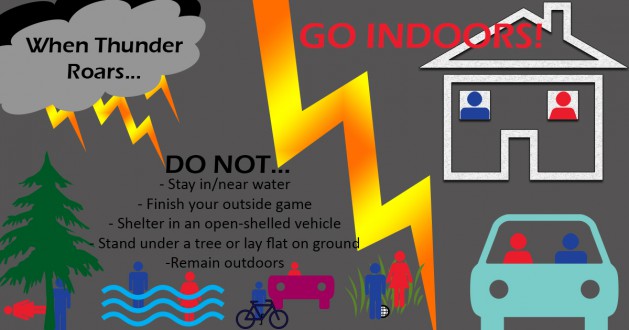Summertime brings about boating, camping, festivals, cookouts, and many other recreational activities – OUTDOORS. Although a lot more people enjoy the great outdoors during the summer, this season also brings about one of the nation’s deadliest weather phenomena – lightning.
According to the National Weather Service, “Lightning is one of the most erratic and unpredictable characteristics of a thunderstorm. However, knowing and following proven lightning safety guidelines can greatly reduce the risk of injury or death” (www.weather.gov/iln/lightningsafetyweek).
The warm and humid climate of the Southeast makes its states more susceptible to thunderstorms and ultimately lightning strikes. The “Top 5 Lightning Prone States,” according to The Weather Channel (www.weather.com) are:
- #1 – Florida, average 24.7 strikes/square mile, estimated 1,414,284 strikes/year
- #2 – Louisiana, average 19.7 strikes/square mile, estimated 909,919 strikes/year
- #3 – Mississippi, average 18.4 strikes/square mile, estimated 875,720 strikes/year
- #4 – Alabama, average 16 strikes/square mile, estimated 826,473 strikes/year
- #5 – Arkansas, average 15.2 strikes/square mile, estimated 810,444 strikes/year
With a regular occurrence of thunderstorms, it is important for residents and visitors alike to be aware of the dangers and myths associated with lightning strikes. Lifeguard Ambulance would like to
provide some warnings and safety tips in regards to lightning strikes in preparation of the National Lightning Safety Week (June 24-30) and as part of their “Summer Safety Series.”
Lightning Myths, Facts, and Tips:
The National Weather Service posted these lightning myths and facts as part of “Lightning Safety Week” (https://www.weather.gov/iln/lightningsafetyweek):
- Myth: If it is not raining or you cannot see clouds, then you are safe from lightning. Fact: Lightning can strike as far as 25 miles away from the center of the thunderstorm or rain cloud. Tip: If you’re going to be outdoors, check the weather first. If thunderstorms are forecasted, rearrange your plans, so that you are not outside during the projected storm time.
- Myth: You can be electrocuted by touching a lightning strike victim. Fact: The human body does not store electrical current. Tip: If you see someone who has been struck by lightning, call 911 immediately and begin CPR.
- Myth: Rubber soles of shoes or tires on a vehicle protect you from lightning by insulating you from the ground. Fact: Rubber-soled shoes and tires provide NO protection from lightning. While most cars are safe from lightning, the metal roof and metal sides protect you, not the tires; the electricity goes through the metal frame and to the ground. Tip: Do not lean on the doors or windows inside the car during a thunderstorm. Remember, convertibles, motorcycles, bicycles, and open-shelled outdoor recreational vehicles do not protect you from lightning.
- Myth: If you are trapped outside during a thunderstorm, lie flat on the ground or seek shelter under a tree. Fact: Laying flat on the ground increases your chance of being affected by potentially deadly ground current and being underneath a tree is the second-leading cause of lightning casualties. Tip: If you are caught outside during a thunderstorm, keep moving quickly towards shelter.
Other Lightning Safety Tips:
- Remain alert:
- Monitor the local weather conditions and forecast
- Keep an eye and ear on the sky: watch for darkening clouds, changes in the wind, flashes of lightning and listen for claps of thunder
Seek shelter:
- Being outside during a thunderstorm is NEVER safe
- Go inside a fully enclosed building, not just a park pavilion or other covered areas
- Stay off corded phones, computers, and other equipment that puts you in direct contact with electricity
- Avoid plumbing, including sinks, baths, and faucets
- Stay in safe shelter at least 30 minute after you hear the last clap of thunder
Plan ahead for outdoor activities:
- Move to a safe place quickly if the sky looks threatening or you hear thunder
- Don’t wait to finish your game or other outdoor activity.
- Go indoors immediately upon realizing bad weather is approaching or is already in the area.
If caught outside with no safe shelter nearby:
- Get off elevated areas such as hills, bridges, or highway overpasses
- Do not lie flat on the ground or shelter under an isolated tree
- Immediately get out of and away from any body of water, including pools, ponds, rivers, lakes, etc.
- Stay away from objects that conduct electricity, such as power lines, electric fences, or barbed wire fences
If you see someone struck by lightning, call 9-1-1 immediately for medical assistance. If the victim is not breathing, begin CPR, as starting CPR may be critically important to saving their lives. Other
victims may not require CPR but still need medical attention.
*Note - Lifeguard jointly released versions of this PSA with Humphreys County, Lamar County, Panola County, and Santa Rosa County Emergency Management.
